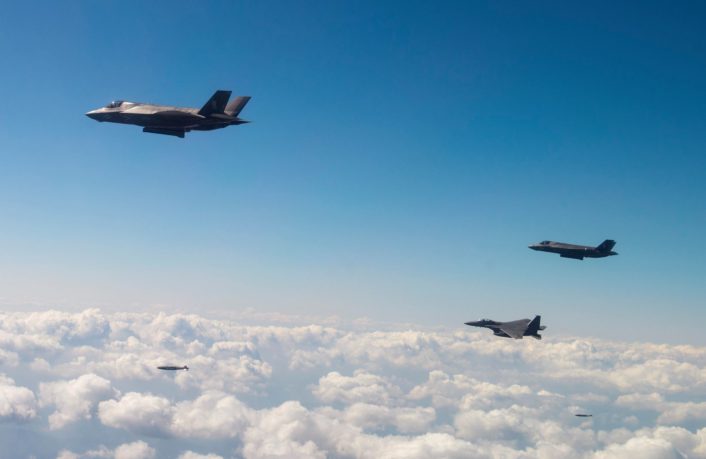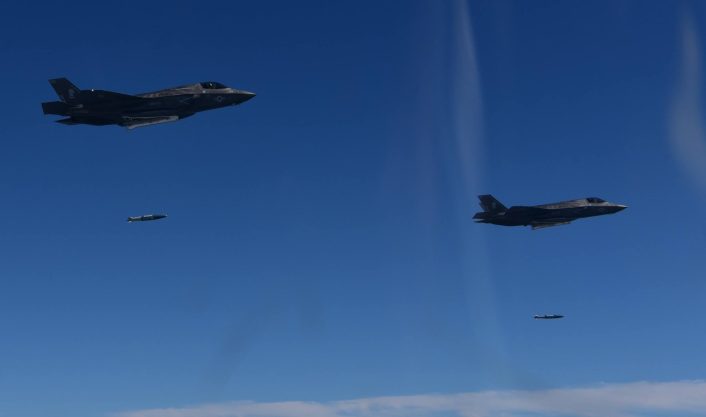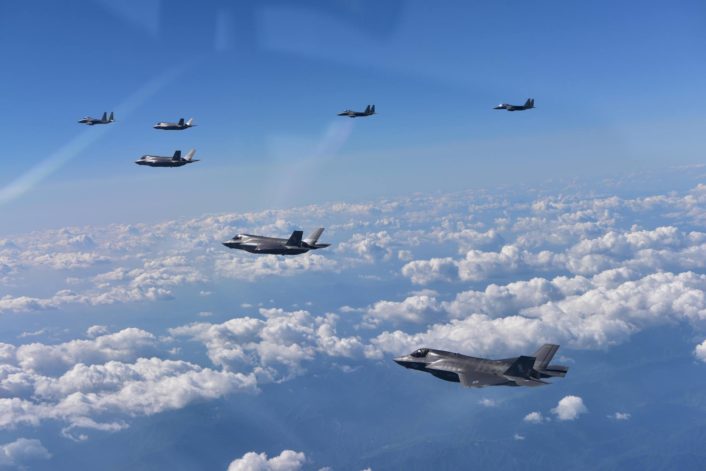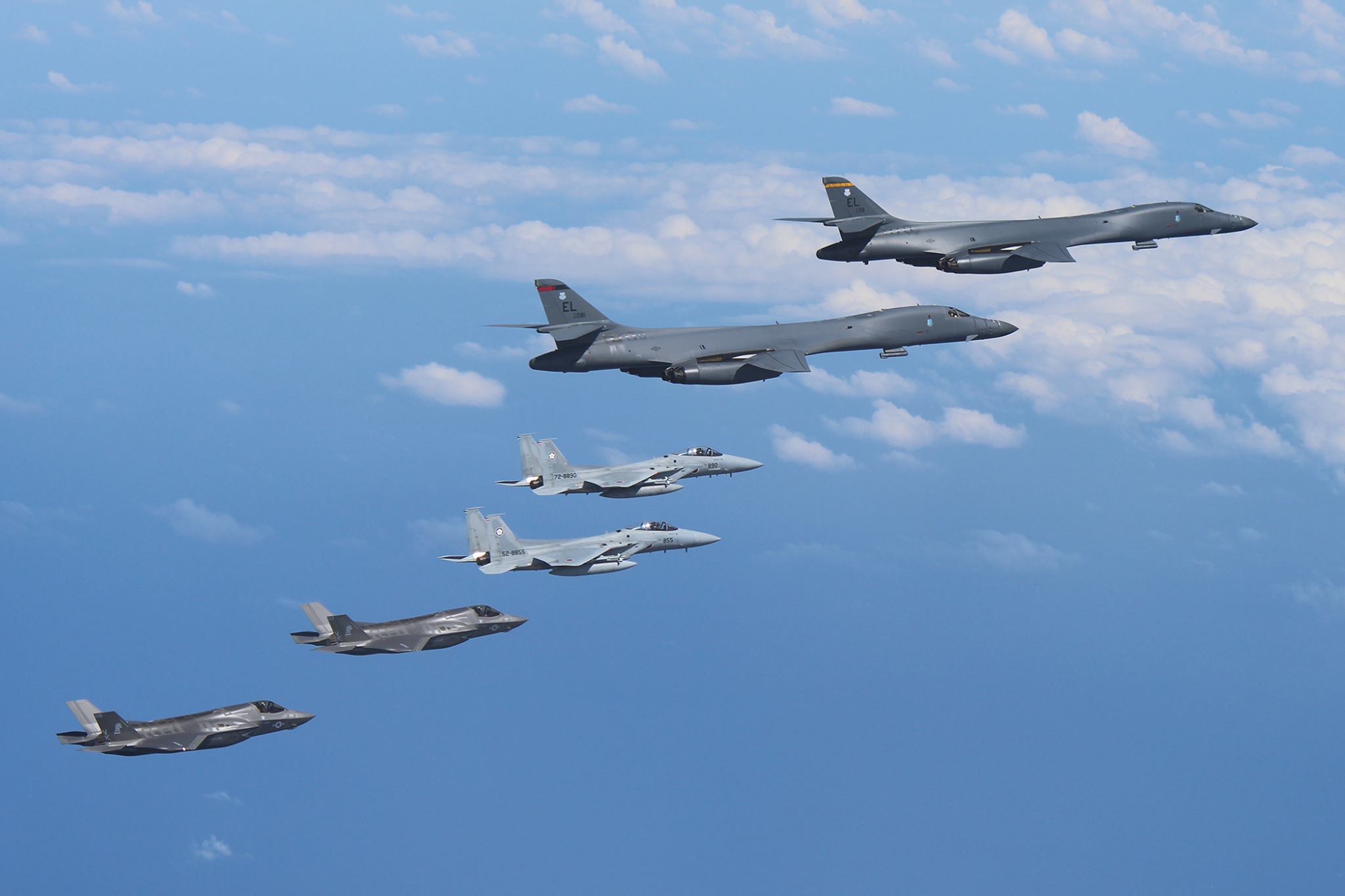The U.S. Marine Corps F-35B Lightning II, joined United States Air Force B-1B Lancers for the first time in a show of force over the Korean Peninsula.
On Aug. 30, two B-1Bs from Andersen Air Force Base, Guam accompanied by two Koku Jieitai (Japan Air Self-Defense Force) F-15Js and four Republic of Korea Air Force (ROKAF) F-15Ks took part in a joint mission over South Korea: a direct response to North Korea’s intermediate-range ballistic missile launch which flew directly over northern Japan on August 28 amid rising tension over North Korea’s nuclear and ballistic missile development programs.
Even though such missions have become more or less a routine, what make the latest “show of force” a bit more interesting is the participation of four U.S. Marine Corps F-35B Lightning II that joined the USAF Lancers for a 10-hour mission that brought the “package” over waters near Kyushu, Japan, then across the Korean Peninsula to release live weapons at the Pilsung Range training area before returning to their respective home stations.
Although the F-35B is the most modern combat plane in the region and can theoretically be used as part of a larger package to hit very well defended North Korean targets in case of war, the presence of a handful stealth multirole aircraft is mainly symbolic.
Marine Fighter Attack Squadron 121 (VMFA-121), an F-35B squadron with 3rd Marine Aircraft Wing that achieved IOC (Initial Operational Capability) with the JSF on Jul. 31, 2015, relocated to MCAS Iwakuni, Japan, from MCAS (Marine Corps Air Station) Yuma, Arizona, on Jan. 9, 2017.
In October 2016, a contingent of 12 F-35Bs took part in Developmental Test III aboard USS America followed by the Lightning Carrier “Proof of Concept” demonstration on the carrier on Nov. 19, 2016.
During the POC, the aircraft proved it can operate at-sea, employing a wide array of weapons loadouts with the newest software variant and some of the most experienced F-35B pilots said that “the platform is performing exceptionally.”

In case of war, the stealthy aircraft would only be part of a wider military force including U.S. Air Force B-52 Stratofortress and B-2 Spirit stealth bombers (that have already conducted extended deterrence missions over the Korean Peninsula in the past years) along with the B-1B Lancers already deployed to Guam to support the U.S. Pacific Command’s (USPACOM) Continuous Bomber Presence mission; as well as other USAF assets from land bases and U.S. Navy aircraft from aircraft carriers, such as the F-16 in Wild Weasel role and the EA-18G Growlers Electronic Attack, to name but few.
In fact, the F-35s would be involved in the Phase 4 of an eventual pre-emptive air strike on Pyongyang, the phase during which tactical assets would be called to hunt road-mobile ballistic missiles and any other artillery target that North Korea could use to launch a retaliatory attack (even a nuclear one) against Seoul.
During the Aug. 30 mission, the F-35Bs flew with the radar reflectors used to make LO (Low Observable) aircraft clearly visible on radars: a sign they didn’t want their actual radar signature to be exposed to any intelligence gathering sensor in the area. Furthermore , the Joint Strike Fighters also dropped their 1,000-lb GBU-32 JDAMs (Joint Direct Attack Munitions) on Pilsung firing range.

With a “first day of war” configuration the F-35B would likely carry weapons internally to maintain low radar cross-section and observability from sensors as done during the mission flown yesterday. However, as a conflict evolves and enemy air defense assets including sensors, air defense missile and gun systems and enemy aircraft, are degraded by airstrikes the environment becomes more permissive and the F-35 no longer relies on low-observable capability for survivability. This is when the Lightning II would shift to carrying large external loads to accelerate the prosecution of ground targets in an effort to overwhelm an adversary with highly effective precision strikes.
Moreover, during the opening stages of an air war, the F-35Bs would be able to act as real-time data coordinators able to correlate and disseminate information gathered from their on board sensors to other assets contributing to achieve the “Information Superiority” required to geo-locate the threats and target them effectively.
“The F-35 embodies our commitment to our allies and contributes to the overall security and stability of the Indo-Asia-Pacific region,” said Lt. Gen. David H. Berger, commander, U.S. Marine Corps Forces Pacific in a PACAF release. “By forward-basing the F-35, the most advanced aircraft in the world, here in the Pacific, we are enabling the Marine Corps to respond quickly during a crisis in support of Japan, the Republic of Korea, and all our regional partners.”














